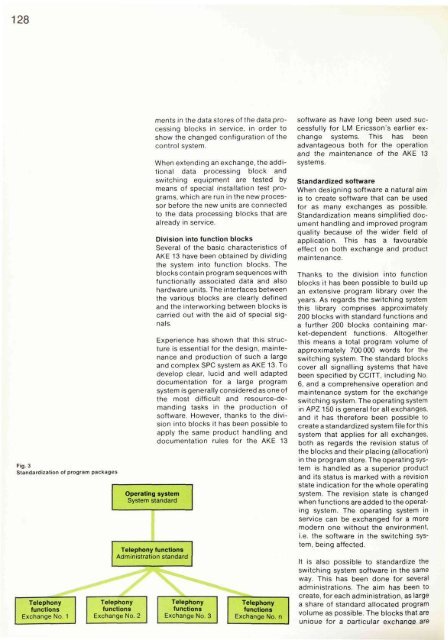Selection and Testing of Electronic Components for LM
Selection and Testing of Electronic Components for LM
Selection and Testing of Electronic Components for LM
You also want an ePaper? Increase the reach of your titles
YUMPU automatically turns print PDFs into web optimized ePapers that Google loves.
128<br />
Fig. 3<br />
St<strong>and</strong>ardization <strong>of</strong> program packages<br />
merits in the data stores <strong>of</strong> the data processing<br />
blocks in service, in order to<br />
show the changed configuration <strong>of</strong> the<br />
control system.<br />
When extending an exchange, the additional<br />
data processing block <strong>and</strong><br />
switching equipment are tested by<br />
means <strong>of</strong> special installation test programs,<br />
which are run in the new processor<br />
be<strong>for</strong>e the new units are connected<br />
to the data processing blocks that are<br />
already in service.<br />
Division into function blocks<br />
Several <strong>of</strong> the basic characteristics <strong>of</strong><br />
AKE 13 have been obtained by dividing<br />
the system into function blocks. The<br />
blocks contain program sequences with<br />
functionally associated data <strong>and</strong> also<br />
hardware units. The interfaces between<br />
the various blocks are clearly defined<br />
<strong>and</strong> the interworking between blocks is<br />
carried out with the aid <strong>of</strong> special signals.<br />
Experience has shown that this structure<br />
is essential <strong>for</strong> the design, maintenance<br />
<strong>and</strong> production <strong>of</strong> such a large<br />
<strong>and</strong> complex SPC system as AKE 13. To<br />
develop clear, lucid <strong>and</strong> well adapted<br />
documentation <strong>for</strong> a large program<br />
system is generally considered as one <strong>of</strong><br />
the most difficult <strong>and</strong> resource-dem<strong>and</strong>ing<br />
tasks in the production <strong>of</strong><br />
s<strong>of</strong>tware. However, thanks to the division<br />
into blocks it has been possible to<br />
apply the same product h<strong>and</strong>ling <strong>and</strong><br />
documentation rules <strong>for</strong> the AKE 13<br />
s<strong>of</strong>tware as have long been used successfully<br />
<strong>for</strong> <strong>LM</strong> Ericsson's earlier exchange<br />
systems. This has been<br />
advantageous both <strong>for</strong> the operation<br />
<strong>and</strong> the maintenance <strong>of</strong> the AKE 13<br />
systems.<br />
St<strong>and</strong>ardized s<strong>of</strong>tware<br />
When designing s<strong>of</strong>tware a natural aim<br />
is to create s<strong>of</strong>tware that can be used<br />
<strong>for</strong> as many exchanges as possible.<br />
St<strong>and</strong>ardization means simplified document<br />
h<strong>and</strong>ling <strong>and</strong> improved program<br />
quality because <strong>of</strong> the wider field <strong>of</strong><br />
application. This has a favourable<br />
effect on both exchange <strong>and</strong> product<br />
maintenance.<br />
Thanks to the division into function<br />
blocks it has been possible to build up<br />
an extensive program library over the<br />
years. As regards the switching system<br />
this library comprises approximately<br />
200 blocks with st<strong>and</strong>ard functions <strong>and</strong><br />
a further 200 blocks containing market-dependent<br />
functions. Altogether<br />
this means a total program volume <strong>of</strong><br />
approximately 700 000 words <strong>for</strong> the<br />
switching system. The st<strong>and</strong>ard blocks<br />
cover all signalling systems that have<br />
been specified by CCITT, including No.<br />
6, <strong>and</strong> a comprehensive operation <strong>and</strong><br />
maintenance system <strong>for</strong> the exchange<br />
switching system. The operating system<br />
in APZ 150 is general <strong>for</strong> all exchanges,<br />
<strong>and</strong> it has there<strong>for</strong>e been possible to<br />
create a st<strong>and</strong>ardized system file <strong>for</strong>this<br />
system that applies <strong>for</strong> all exchanges,<br />
both as regards the revision status <strong>of</strong><br />
the blocks <strong>and</strong> their placing (allocation)<br />
in the program store. The operating system<br />
is h<strong>and</strong>led as a superior product<br />
<strong>and</strong> its status is marked with a revision<br />
state indication <strong>for</strong> the whole operating<br />
system. The revision state is changed<br />
when functions are added to the operating<br />
system. The operating system in<br />
service can be exchanged <strong>for</strong> a more<br />
modern one without the environment,<br />
i.e. the s<strong>of</strong>tware in the switching system,<br />
being affected.<br />
It is also possible to st<strong>and</strong>ardize the<br />
switching system s<strong>of</strong>tware in the same<br />
way. This has been done <strong>for</strong> several<br />
administrations. The aim has been to<br />
create, <strong>for</strong> each administration, as large<br />
a share <strong>of</strong> st<strong>and</strong>ard allocated program<br />
volume as possible. The blocks that are<br />
uniaue <strong>for</strong> a particular exchanqe are
















